| Listing 1 - 10 of 14 | << page >> |
Sort by
|
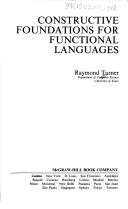
ISBN: 0077074114 9780077074111 Year: 1991 Publisher: London : McGraw-Hill,
Abstract | Keywords | Export | Availability | Bookmark
 Loading...
Loading...Choose an application
- Reference Manager
- EndNote
- RefWorks (Direct export to RefWorks)
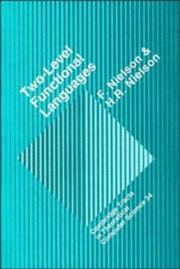
ISBN: 0521403847 Year: 1992 Publisher: New York (N.Y.) : Cambridge university press,
Abstract | Keywords | Export | Availability | Bookmark
 Loading...
Loading...Choose an application
- Reference Manager
- EndNote
- RefWorks (Direct export to RefWorks)
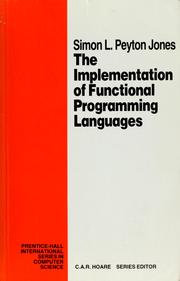
ISBN: 013453333X 0134533259 9780134533339 9780134533254 Year: 1987 Publisher: Englewood Cliffs, NJ: Prentice Hall,
Abstract | Keywords | Export | Availability | Bookmark
 Loading...
Loading...Choose an application
- Reference Manager
- EndNote
- RefWorks (Direct export to RefWorks)
Programming --- Functional programming languages --- 681.3*D34 --- Processors: code generation; compilers; interpreters; optimization; parsing; preprocessors; run-time environments; translator writing systems and compilergenerators (Programming languages) --- Functional programming languages. --- 681.3*D34 Processors: code generation; compilers; interpreters; optimization; parsing; preprocessors; run-time environments; translator writing systems and compilergenerators (Programming languages) --- Programming languages (Electronic computers) --- Electronic digital computers programming --- Computer programming.
Book
ISBN: 1786468832 9781786468833 9781786465023 1786465027 Year: 2016 Publisher: Birmingham, England : Packt Publishing,
Abstract | Keywords | Export | Availability | Bookmark
 Loading...
Loading...Choose an application
- Reference Manager
- EndNote
- RefWorks (Direct export to RefWorks)
Master the art of creating scalable, concurrent, and reactive applications using Akka About This Book This book will help you cure anemic models with domain-driven design We cover major Akka programming concepts such as concurrency, scalability, and reactivity You will learn concepts like Event Sourcing and CQRS via Akka Persistence, Akka Streams, Akka Http as well as Akka Clustering Who This Book Is For If you want to use the Lightbend platform to create highly performant reactive applications, then this book is for you. If you are a Scala developer looking for techniques to use all features of the new Akka release and want to incorporate these solutions in your current or new projects, then this book is for you. Expert Java developers who want to build scalable, concurrent, and reactive application will find this book helpful. What You Will Learn Use Akka actors to enable parallel execution Build out domain-driven design based components like entities and aggregates Respond to command requests on that aggregate root that affect the internal state Leverage Akka Persistence, protobuf and Cassandra to save the persistent state of you entities Build out complex processing graphs with the Graph Builder DSL Understand the dynamic push/pull nature of backpressure handling within Akka Streams Route HTTP requests to an actor and return a response Deploy actor instances across a set of nodes via ConductR for high availability In Detail For a programmer, writing multi-threaded applications is critical as it is important to break large tasks into smaller ones and run them simultaneously. Akka is a distributed computing toolkit that uses the abstraction of the Actor model, enabling developers to build correct, concurrent, and distributed applications using Java and Scala with ease. The book begins with a quick introduction that simplifies concurrent programming with actors. We then proceed to master all aspects of domain-driven design. We’ll teach you how to scale out with Akka Remoting/Clustering. Finally, we introduce Conductr as a means to deploy to and manage microservices across a cluster. Style and approach This comprehensive, fast-paced guide is packed with several real-world use cases that will help you understand concepts, issues, and resolutions while using Akka to create highly performant, scalable, and concurrency-proof reactive applications. Downloading the example code for this book. You can download the example code files for all Packt boo...
Scala (Computer program language) --- Application software --- Java (Computer program language) --- Object-oriented programming languages --- JavaSpaces technology --- Development of application software --- Functional programming languages --- Multiparadigm programming (Computer science) --- Development. --- Programming
Multi
ISBN: 9780521760300 0521760305 9780521757607 0521757606 9780511778377 9780511932700 0511932707 0511778376 9786612930737 661293073X 1107207797 9781107207790 1282930737 9781282930735 0511931360 9780511931369 0511927517 9780511927515 0511924976 9780511924972 051193002X Year: 2010 Publisher: Cambridge : Cambridge University Press,
Abstract | Keywords | Export | Availability | Bookmark
 Loading...
Loading...Choose an application
- Reference Manager
- EndNote
- RefWorks (Direct export to RefWorks)
Computational semantics is the art and science of computing meaning in natural language. The meaning of a sentence is derived from the meanings of the individual words in it, and this process can be made so precise that it can be implemented on a computer. Designed for students of linguistics, computer science, logic and philosophy, this comprehensive text shows how to compute meaning using the functional programming language Haskell. It deals with both denotational meaning (where meaning comes from knowing the conditions of truth in situations), and operational meaning (where meaning is an instruction for performing cognitive action). Including a discussion of recent developments in logic, it will be invaluable to linguistics students wanting to apply logic to their studies, logic students wishing to learn how their subject can be applied to linguistics, and functional programmers interested in natural language processing as a new application area.
Programming --- Lexicology. Semantics --- Mathematical linguistics --- Functional programming (Computer science) --- Haskell (Computer program language) --- Programming languages (Electronic computers) --- Programming language semantics --- Semantics --- Declarative programming languages --- Functional programming languages --- Computer programming --- Semantics. --- Arts and Humanities --- Language & Linguistics
Book
ISBN: 0632015063 0632017392 9780632015061 9780632017393 Year: 1987 Publisher: Oxford : Blackwell,
Abstract | Keywords | Export | Availability | Bookmark
 Loading...
Loading...Choose an application
- Reference Manager
- EndNote
- RefWorks (Direct export to RefWorks)
Programming --- Functional programming languages --- Langages de programmation fonctionnels --- 681.3*D11 --- 681.3*D32 --- Applicative (functional) programming --- language classifications: applicative languages; data-flow languages; design languages; extensible languages; macro and assembly languages; nonprocedural languages; specialized application and very high-level languages (Programminglanguages) --- Functional programming languages. --- 681.3*D32 language classifications: applicative languages; data-flow languages; design languages; extensible languages; macro and assembly languages; nonprocedural languages; specialized application and very high-level languages (Programminglanguages) --- 681.3*D11 Applicative (functional) programming --- Programming languages (Electronic computers) --- Functional programming
Book
ISBN: 0201114585 Year: 1988 Publisher: Reading (Mass.) : Addison-Wesley,
Abstract | Keywords | Export | Availability | Bookmark
 Loading...
Loading...Choose an application
- Reference Manager
- EndNote
- RefWorks (Direct export to RefWorks)
Programming --- COMMON LISP (Computer program language) --- Common Lisp (Langage de programmation) --- 681.3*D32 --- Functional programming languages --- Object-oriented programming languages --- language classifications: applicative languages; data-flow languages; design languages; extensible languages; macro and assembly languages; nonprocedural languages; specialized application and very high-level languages (Programminglanguages) --- COMMON LISP (Computer program language). --- 681.3*D32 language classifications: applicative languages; data-flow languages; design languages; extensible languages; macro and assembly languages; nonprocedural languages; specialized application and very high-level languages (Programminglanguages)
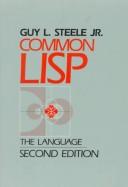
ISBN: 1555580416 1555580424 0131524143 9781555580414 9781555580421 Year: 1990 Publisher: Bedford, Mass.: Digital Press,
Abstract | Keywords | Export | Availability | Bookmark
 Loading...
Loading...Choose an application
- Reference Manager
- EndNote
- RefWorks (Direct export to RefWorks)
In this greatly expanded edition of the defacto standard, you'll learn about the nearly 200 changes already made since original publication - and find out about gray areas likely to be revised later. Written by the Vice- Chairman of X3J13 (the ANSI committee responsible for the standardization of Common Lisp) and co-developer of the language itself, the new edition contains the entire text of the first edition plus six completely new chapters. They cover: - CLOS, the Common Lisp Object System, with new features to support function overloading and object-oriented programming, plus complete technical specifications * Loops, a powerful control structure for multiple variables * Conditions, a generalization of the error signaling mechanism * Series and generators * Plus other subjects not part of the ANSI standards but of interest to professional programmers. Throughout, you'll find fresh examples, additional clarifications, warnings, and tips - all presented with the author's customary vigor and wit.
Programming --- COMMON LISP (Computer program language) --- #TELE:ELEN --- 681.3*D32 --- Functional programming languages --- Object-oriented programming languages --- language classifications: applicative languages; data-flow languages; design languages; extensible languages; macro and assembly languages; nonprocedural languages; specialized application and very high-level languages (Programminglanguages) --- COMMON LISP (Computer program language). --- 681.3*D32 language classifications: applicative languages; data-flow languages; design languages; extensible languages; macro and assembly languages; nonprocedural languages; specialized application and very high-level languages (Programminglanguages) --- Common lisp (computer program language)
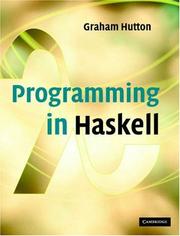
ISBN: 9780521871723 9780521692694 0521692695 0521871727 Year: 2007 Publisher: Cambridge: Cambridge university press,
Abstract | Keywords | Export | Availability | Bookmark
 Loading...
Loading...Choose an application
- Reference Manager
- EndNote
- RefWorks (Direct export to RefWorks)
Programming --- Haskell (Computer program language) --- language classifications: applicative languages; data-flow languages; design languages; extensible languages; macro and assembly languages; nonprocedural languages; specialized application and very high-level languages (Programminglanguages) --- 681.3*D32 language classifications: applicative languages; data-flow languages; design languages; extensible languages; macro and assembly languages; nonprocedural languages; specialized application and very high-level languages (Programminglanguages) --- 681.3*D32 --- Declarative programming languages --- Functional programming languages
Book
ISBN: 0932376878 Year: 1987 Publisher: Bedford, Mass. Digital Press
Abstract | Keywords | Export | Availability | Bookmark
 Loading...
Loading...Choose an application
- Reference Manager
- EndNote
- RefWorks (Direct export to RefWorks)
Programming --- Artificial intelligence. Robotics. Simulation. Graphics --- COMMON LISP (Computer program language) --- 681.3*D32 --- Functional programming languages --- Object-oriented programming languages --- language classifications: applicative languages; data-flow languages; design languages; extensible languages; macro and assembly languages; nonprocedural languages; specialized application and very high-level languages (Programminglanguages) --- COMMON LISP (Computer program language). --- 681.3*D32 language classifications: applicative languages; data-flow languages; design languages; extensible languages; macro and assembly languages; nonprocedural languages; specialized application and very high-level languages (Programminglanguages) --- Common Lisp (Langage de programmation)
| Listing 1 - 10 of 14 | << page >> |
Sort by
|

 Search
Search Feedback
Feedback About UniCat
About UniCat  Help
Help News
News